This post was first published by Jamie Calvetti on LinkedIn
Much like fashion styles, food trends are fleeting. With the rise of innovation in our fast paced society, consumers are looking for more multi-faceted unique experiences. 2016 has been named the year of ‘multiple personalities’. Concepts such as fungi frenzy are coming to the food forefront. Caterers, hoteliers and chefs will flex their creative muscles in order to satisfy their many audiences. This increases the pressure (pun intended) to produce food, which is not only creative and well presented, but also maintains its standards while prepared in half the time. Can the industry handle it?
So many trends, so few results
While the fine dining experience produces excitement and a desire for something new, many consumers find it unpredictable and disappointing. The expectation for new concepts and new creative culinary experiences can often increase the potential for disappointment. Food consumption is emotional and memorable, both positively and negatively. That’s a lot for customers, chefs and restaurateurs to handle.
Millennials want it fast but at what cost?
Millennials are driving a significant shift in the dining culture. They demand tasty, fast, reasonably priced, healthy food of the highest caliber. “Millennials are food-aware, food-serious, and food-adventurous,” says Rachel Kalt, senior strategist at The Culinary Edge, a culinary consulting firm and design agency. “But they also put a high level of importance on value.” Menus are changing. Chefs realize they must be adaptable to their audience. The latest craze for Millennials is the chef-driven fast-casual restaurants, where Millennials want quality food, on the go.
The pressure for airlines to produce high quality meals.
The need for speed in the airline industry doesn’t just refer to getting from one destination to the next. Emirates Flight Catering produces upwards of 55 million meals a year. Each meal is expected to be tasty, well prepared and hygienic with a high standard. In the past some airlines had a bad reputation when it came to their meals and got away with it. Times have changed; consistency, hygiene and quality control are the new standard. That’s a significant goal to meet at high volumes.
The Sous Vide Advantage
In the dining world, sous vide prepared foods continue to be advantageous for chefs and consumers alike. Precise temperature control, uniformity of heating and the resulting pasteurization maintain the integrity of the food and yields superior results. Quality, taste, and consistency help explain why real sous vide foods continue to rise in popularity.
It’s easy for food writers to call sous vide a trend, but when a trend becomes mass market (as it has), it’s time to realize that sous vide produced foods are not a transient food fad. Sous vide is a cooking technique that’s here to stay. Its advantages cannot be debunked.
One thing is for sure, when the food fluctuations settle, consistency always wins.

